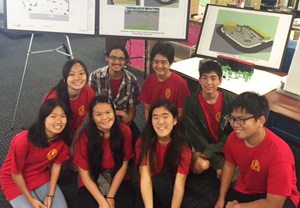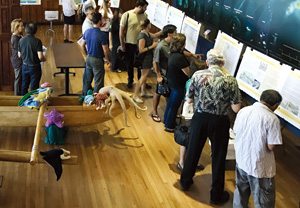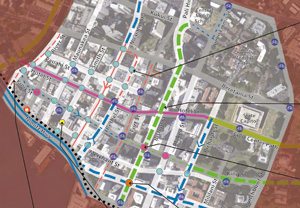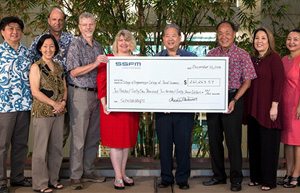SSFM Blog
SSFM News
SSFM is greatly diversified in the services we provide, the markets we serve and the
problems we solve. SSFM’s Blog highlights activities, accomplishments, insights and
observations that offer a further glimpse into the dynamics of our practice.
SSFM is greatly diversified in the services we provide, the markets we serve and the problems we solve. SSFM’s Blog highlights activities, accomplishments, insights and observations that offer a further glimpse into the dynamics of our practice.
June 26, 2019
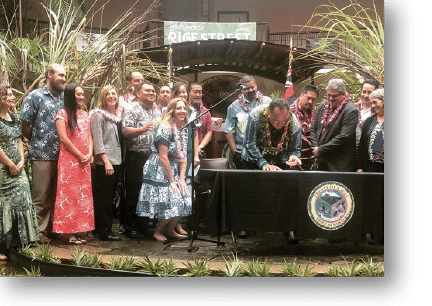 Hawaii’s Kīlauea volcano ranks first among volcanoes in the United States for the potential severity of impact on human lives and infrastructure. The County of Hawaiʻi has launched a Kīlauea Eruption recovery website to provide information to the community about the eruption impacts, recovery efforts, and opportunities for community engagement.
Hawaii’s Kīlauea volcano ranks first among volcanoes in the United States for the potential severity of impact on human lives and infrastructure. The County of Hawaiʻi has launched a Kīlauea Eruption recovery website to provide information to the community about the eruption impacts, recovery efforts, and opportunities for community engagement.
More / Less
more text
April 2019
 Kauai County General Plan wins the American Planning Association’s top National Excellence Award for comprehensive planning.
Kauai County General Plan wins the American Planning Association’s top National Excellence Award for comprehensive planning.
The American Planning Association has selected the General Plan Update for the County of Kauai, Kauai Kākou, as the recipient of the 2019 Daniel Burnham Award. APA’s Daniel Burnham Award is the most prestigious honor the organization bestows for excellence in comprehensive planning.
More / Less
SSFM served as the Prime Consultant for the update of the Kauai General Plan. The General Plan is the guiding policy document for the County of Kauai, setting the island wide vision and goals, identifying Kauai’s unique qualities to be protected and preserved, and directing where and how growth should occur to ensure sustainability, resilience, and opportunity for all over the next twenty years. The project team deployed community engagement that sought widespread participation in developing a new General Plan framework consisting of a Vision statement, four overarching Goals, nineteen key Policies, 42 Objectives, and 607 Actions. The Plan was adopted by the Kauai County Council in 2018 and received the APA Hawaii Chapter’s 2018 Outstanding Planning Award.
Read more at: http://plankauai.com/
and https://www.planning.org/awards/2019/kauai/
“We are proud to be recognized as part of the team that developed this plan. The process was particularly groundbreaking in the way that it engaged the community throughout its development. The resulting plan views the entire community as a partner in implementation of the vision for Kaua‘i’s future,” explains Melissa White, Senior Planner and Associate at SSFM. “The County’s leadership was visionary in understanding and addressing long-standing community issues head on, and developing an action-oriented framework to guide Kaua‘i in growing responsibly.” The theme of the plan is Kaua’i Kākou, a Hawaiian concept meaning “we’re all in this together.” The planning process embraced collaboration and partnerships among government agencies, civic leaders, non-profit groups and the community. To address residents’ concerns about transparency in implementation, the plan establishes a regular monitoring cycle with several feedback points, and it calls for the creation of the Kākou Committee, which convenes every two years to review the plan.
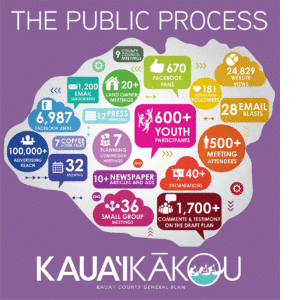 The General Plan Update addresses policy directions, ordinances, land use amendments, and prioritization of capital improvement projects in service of four goals:
The General Plan Update addresses policy directions, ordinances, land use amendments, and prioritization of capital improvement projects in service of four goals:
- A Sustainable Island: Growing responsibly to meet the needs of current and future generations without depleting resources.
- A Unique and Beautiful Place: Stewardship and protection of the natural, cultural, social, and built environment assets that are of value to the community.
- A Healthy and Resilient People: Increasing health, vitality, and resilience of communities through improving the natural, built, and social environment and responding to impacts from climate change.
- An Equitable Place, with Opportunity for All: Fostering diverse and equitable communities with vibrant economies, access to jobs and housing, and a high quality of lift.
The American Planning Association provides leadership in the development of vital communities by advocating excellence in planning, promoting education and citizen empowerment, and providing members with the tools and support necessary to meet the challenges of growth and change and to realize their mission of Creating Better Communities. The organization includes 42,000 members from 100+ countries. APA advances positive planning results through leadership in education, research, advocacy, and ethical practice.
March 2019
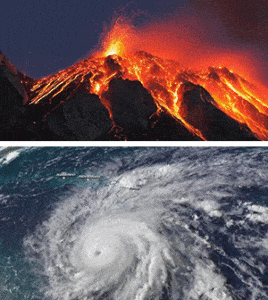 Two Unprecedented Disasters at Once
Two Unprecedented Disasters at Once
First the Volcano…
SSFM’s commitment to service has never been more evident than in responding to the concurrent natural disasters that struck the Big Island of Hawaii last year. Beginning with the sudden eruption of the Kilauea Volcano, and a 6.9 magnitude earthquake, the volcanic activity lasted nearly 4 months and quickly became the most destructive in Hawaii’s recorded history. Communities in the southeast corner of the Island were slowly engulfed by the lava flow. Tremors and geological instability damaged numerous structures and made essential highways impassible.
…And Then the Hurricane
More / Less
Hurricane Lane approached at the height of the intense response to the volcano. While State and County officials were continuing to cope with the dramatic impacts of the still-active volcano, the island was slammed with massive amounts of rain from the outer bands of the hurricane. The epic storm dropped more than 52 inches in a four-day period – the most rainfall from a cyclonic event in the Island’s history and the second most anywhere in the US since 1950. Homes, schools, and businesses were flooded. Vital highways were made impassible by massive mudslides and flooding. The destruction wrought by either of these natural disasters alone would have had a devastating impact on the Island’s infrastructure. Their combined impact was nearly overwhelming. Together, the volcano and hurricane ruptured the only transportation linkages between the east and west sides of the island and had direct impact on the many communities that lie in between.
Turning to SSFM for Help
Remediating the damage to the State roads fell to the State Department of Transportation (DOT) District Office in Hilo. In the immediate aftermath of the eruption, DOT needed to act quickly but lacked the internal resources to address such massive challenges. SSFM was a logical place to turn to for the necessary supplemental resources and expertise, due to the firm’s multidiscipline capabilities, familiarity with the State procedures and Federal requirements and their readiness to respond. 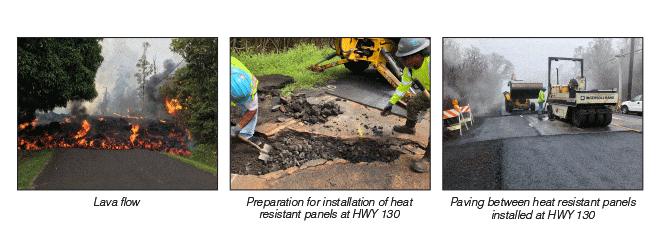 The first call to SSFM came just a few days after the first fissures began spewing lava. Each day brought multiple seismic events as more fissures opened in Leilani Estates and lava flows threatened the homes of hundreds of residents. State highways critical to the Island’s transportation infrastructure and economy were becoming increasingly impassible from Pahoa to Volcano due to cracks or sinkholes forming along the roads.
The first call to SSFM came just a few days after the first fissures began spewing lava. Each day brought multiple seismic events as more fissures opened in Leilani Estates and lava flows threatened the homes of hundreds of residents. State highways critical to the Island’s transportation infrastructure and economy were becoming increasingly impassible from Pahoa to Volcano due to cracks or sinkholes forming along the roads.
Commitment
Austen Drake, SSFM’s General Manager for Hawaii Island said there was never any doubt about what the company would do. “This is where we live. It’s our community and it’s the roads we drive on every day. The only thing to do was mobilize our team and help any way we could.” The company’s efforts were led by Senior Project Engineer Robyn Ito and Construction Manager Renee Ishisaka. Ultimately, they were supported by a ten person team, including permit specialist Jennifer Scheffel.
Facing the Challenge
There was no roadmap to follow in responding. “When you’re an engineer on the Island of Hawaii, you’re aware of lots of design solutions related to eruptions, but not 5.5 magnitude earthquakes rattling the earth on a daily basis,” Drake said. The entire SSFM team was on call 24/7 throughout the crisis. Ito recalls “For us, the phone didn’t stop ringing just because it was a Saturday or Sunday, 6 o’clock in the morning, or 9 o’clock at night.” The team collaborated with state officials at all hours of the day and night to inspect new damage and identify quick fix solutions or alternative routes in order to keep the highway system functioning. Each day, the entire roadway system in the vicinity of the volcano was inspected for new cracks and sinkholes with triage the order of the day, every day. The highest priority was maintaining a safe route for emergency vehicles. Due to the extreme topography of the Big Island, there are not many road options. An impassable route is the difference between 20 minutes or 3 hours to the nearest emergency facility. SSFM’s construction management team, led by Ishisaka, remained on call around the clock to ensure provisions were in place to keep traffic moving while road repairs were being performed. Working with contractors, establishing traffic control, and ensuring no invasive species enter the sensitive National Park areas were just a small part of what Ishisaka’s team did each day. Her team also managed the installation of some rather innovative slope stability solutions, such as welded wire frames, not commonly used on the Big Island. 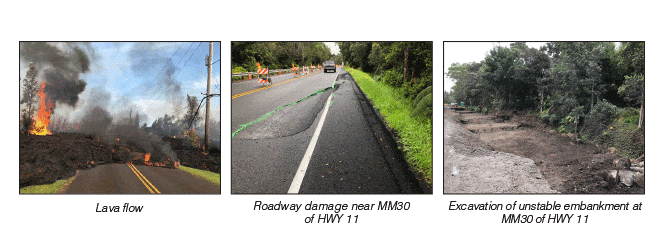 In addition to the physical repairs, environmental processing was necessary with numerous County, State and Federal agencies. The State and County relied on SSFM’s Strategic Services Group to assist with obtaining environmental clearances to allow work to continue without unimpeded. After the hurricane, it became critical for DOT to fortify bridge abutments and piers that were undermined by the flood waters. There were also multiple landslides along the Hamakua Coast, an area whose community’s only link to emergency services and other essentials is Mamalahoa Highway. With all of these simultaneous recovery efforts, DOT again turned to SSFM for assistance with the environmental clearances and with managing the multiple on-going emergency repairs needed to keep the critical roads open. Much of this repair work was led by SSFM Construction Inspector, Chris Harris. The Hurricane’s effects were felt island-wide. In addition to the Department of Transportation’s needs, the Department of Education also enlisted SSFM in addressing significant damage incurred by schools including classrooms, cafeterias, kitchens, and band rooms. Over the weekend of the hurricane, SSFM mobilized a team, which included engineers from Oahu, to assess flooding impacts at schools in the Hilo and Keaau communities.
In addition to the physical repairs, environmental processing was necessary with numerous County, State and Federal agencies. The State and County relied on SSFM’s Strategic Services Group to assist with obtaining environmental clearances to allow work to continue without unimpeded. After the hurricane, it became critical for DOT to fortify bridge abutments and piers that were undermined by the flood waters. There were also multiple landslides along the Hamakua Coast, an area whose community’s only link to emergency services and other essentials is Mamalahoa Highway. With all of these simultaneous recovery efforts, DOT again turned to SSFM for assistance with the environmental clearances and with managing the multiple on-going emergency repairs needed to keep the critical roads open. Much of this repair work was led by SSFM Construction Inspector, Chris Harris. The Hurricane’s effects were felt island-wide. In addition to the Department of Transportation’s needs, the Department of Education also enlisted SSFM in addressing significant damage incurred by schools including classrooms, cafeterias, kitchens, and band rooms. Over the weekend of the hurricane, SSFM mobilized a team, which included engineers from Oahu, to assess flooding impacts at schools in the Hilo and Keaau communities.
The Road Ahead
Even though Kilauea has quieted and Hurricane Lane is long gone, SSFM continues to work closely with County, State and Federal personnel to ensure the affected communities can maintain their way of life. SSFM, and especially professionals in its Hilo Office, is gratified to have played an important role in assisting in the Island’s return to normalcy. 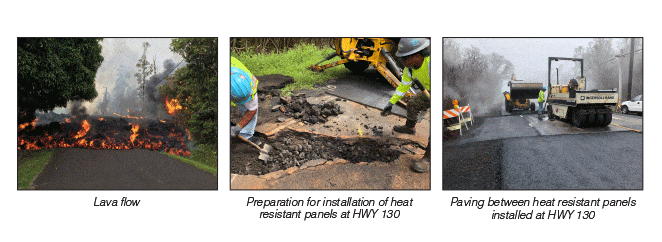
About the Team
Austen Drake, P.E., LEED AP BD+C is the General Manager of SSFM’s Big Island office. He leads the team tackling the Island’s disaster relief program. Austen joined SSFM in 2008. He holds a B.S. in civil engineering from the University of Texas at Arlington.
Robyn Ito, PMP, P.E. is a civil engineer and senior associate with SSFM. Robyn has been with the firm since 2004 and is currently a Senior Project Engineer in SSFM’s Hilo Engineering Group. Robyn holds a degree in Aerospace Engineering from the University of Southern California.
Renee Ishisaka, P.E., S.E., LEED AP is a structural and civil engineer in SSFM’s Hilo office. Renee has been with the firm for over a decade. She holds B.S and M.S degrees in civil engineering from the University of Hawaii at Manoa.
January 2019
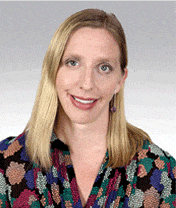 Walk Bike Places
Walk Bike Places
Melissa White, Senior Planner in SSFM’s Strategic Services Group recently had the opportunity to organize and facilitate an “Urban Sustainability Super Session” at the bi-annual Walk Bike Places conference in New Orleans. Hosted by Project for Public Spaces (PPS), a nonprofit organization dedicated to helping people create and sustain public spaces that build strong communities, Walk Bike Places specifically focuses on how to re-imagine neighborhoods as bike-friendly, walkable places. Melissa spoke about her experience and the takeaways from this important facet of building and transforming communities that work for everyone.
More / Less
Q: How is it that you found yourself with a key role in the conference?
MW: I have been involved with PPS for a number of years. Their position at the forefront of the global placemaking movement closely aligns with the work we are doing at SSFM. When invited to lead an “Urban Sustainability Super Session,” I jumped at the opportunity. The session highlighted best practices and case studies around many facets of what makes communities sustainable, including resilience, economic self-sufficiency, social equity, public health, mobility, placemaking, and environmental quality. It was a chance to help shape the current dialogue about how communities should be planning and implementing programs around each of these components.
Q: What is an “Urban Sustainability Super Session?”
MW: It’s a new conference format that Walk Bike Places adopted for 2018, consisting of a three hour session with 8-10 presenters. My session featured eight speakers from the U.S., Canada, and Europe who came from a variety of disciplines and presented on wide-ranging topics including active transportation, parking, air quality, manufacturing, youth leadership, health care, and sustainable street design. To group these diverse speakers and topics, we created two themed segments: “Zoom Out” for those addressing big picture topics of sustainability, and “Zoom In” for those presenting case studies, tools, or methods. Each segment included a panel presentation followed by breakout discussions. The groups then reassembled to share their observations and conclusions.
Q: What were the specific issues addressed by the groups?
MW: We wanted current thinking on how infrastructure, planning, economic development, urban design and even health care delivery can change to meet the challenges posed by climate change, inequality, resource scarcity and heightened social friction, from the very local to the most global perspective.
Q: That’s a lot to bite off. What were the results of the presentations and discussions?
MW: The “Zoom Out” panel focused on understanding and tackling what we called “Wicked Problems of Urban Sustainability.” Presentations included:
- How Parking has Damaged our Cities, Why it Makes People Crazy and How We’re Going to Fix It. Or, How I Learned to Love Parking presented by Martha Roskowski, Further Strategies
- From Air Quality Issues to New Cycling Policy presented by Rick Lindeman, Rijkswaterstaat
- The Urban Generation: How Emerging Leaders are Transforming Their Cities in One Year, presented by Ryan O’Connor, 8 80 Cities
- Drawing Parallels between Europe and North America: How to Build Innovative, Inclusive, and Self-Supporting Communities Leveraging Local DNA presented by Wilco van Bemmel, Dunefield Consulting
Some of the takeaways had to do with how cities can creatively leverage their existing resources to meet sustainability challenges – there is no need to reinvent the wheel. Sometimes it just takes a different angle, such as looking to the past to identify economic infrastructure that can be updated for the future, or involving young people in devising innovative solutions and projects. Existing infrastructure such as bikeways and parking lots can also be creatively upgraded or repurposed to better meet objectives for sustainability, health, and quality of life.
The “Zoom In” panel explored Tools, Tricks, and Case Studies for Sustainable Communities with real world examples including:
- Nurses on Bikes: Health Care Outreach in Vancouver’s Downtown Core presented by Arthur Orsini, Vancouver Coastal Health
- A New Paradigm in Sustainable Street Design: Jackson Street, Saint Paul Minnesota presented by Chris Lambka, Toole Design Group
- Reframing Tactical Urbanism Through Resilience, Dana Wall, The Street Plans Collaborative
- Community Wellbeing – A Framework for Sustainable Communities presented by Antonio Gomez-Palacio, DIALOG
Each of these presenters showcased how they overcame physical, regulatory, or institutional barriers to design innovative tools and projects to further health, sustainable street design, resilience, and community well-being. Each presentation described the tools in enough detail to provide attendees with guidance for implementing similar programs in their own community.
Q: How would you sum up the results from the conference?
MW: We wanted to connect the attendees to ideas, resources, expertise, and partners who see placemaking as the key to addressing some of the greatest sustainability challenges facing the cities and environmental we live in. I think everyone that attended the session came away with plenty of specific tools, examples, and ideas to think about and implement within their own communities. The breakout discussions following each panel were particularly lively, and enabled the speakers to interact with participants and discuss specific applications and ideas that could follow on from their work.
About Melissa White, AICP
Melissa White is a senior planner and associate at SSFM, specializing in placemaking, active transportation, community based economic development, renewable energy, and resilience, all key ingredients to creating thriving, sustainable communities. Ms. White’s projects for both public and private sector clients include long-range community planning, resilience planning, economic development, renewable energy, watershed planning, and resource management.
Melissa received her BS in -Environmental Biology from Southern Oregon University and her MA in Anthropology from the University of Hawai‘i at Mānoa. She has over a decade of experience solving community and environmental planning challenges in Hawaii. She is exceptionally skilled at facilitating outreach programs that bring together community, government, and technical stakeholders to create shared visions and achieve broad community support, resulting in implementable plans for resilient and sustainable communities. Melissa’s training in anthropology and environmental sciences inform cultural and environmental sensitivity in her work.

Walk Bike Places
Melissa White, Senior Planner in SSFM’s Strategic Services Group recently had the opportunity to organize and facilitate an “Urban Sustainability Super Session” at the bi-annual Walk Bike Places conference in New Orleans. Hosted by Project for Public Spaces (PPS), a nonprofit organization dedicated to helping people create and sustain public spaces that build strong communities, Walk Bike Places specifically focuses on how to re-imagine neighborhoods as bike-friendly, walkable places. Melissa spoke about her experience and the takeaways from this important facet of building and transforming communities that work for everyone.
More / Less
Q: How is it that you found yourself with a key role in the conference?
MW: I have been involved with PPS for a number of years. Their position at the forefront of the global placemaking movement closely aligns with the work we are doing at SSFM. When invited to lead an “Urban Sustainability Super Session,” I jumped at the opportunity. The session highlighted best practices and case studies around many facets of what makes communities sustainable, including resilience, economic self-sufficiency, social equity, public health, mobility, placemaking, and environmental quality. It was a chance to help shape the current dialogue about how communities should be planning and implementing programs around each of these components.
Q: What is an “Urban Sustainability Super Session?”
MW: It’s a new conference format that Walk Bike Places adopted for 2018, consisting of a three hour session with 8-10 presenters. My session featured eight speakers from the U.S., Canada, and Europe who came from a variety of disciplines and presented on wide-ranging topics including active transportation, parking, air quality, manufacturing, youth leadership, health care, and sustainable street design. To group these diverse speakers and topics, we created two themed segments: “Zoom Out” for those addressing big picture topics of sustainability, and “Zoom In” for those presenting case studies, tools, or methods. Each segment included a panel presentation followed by breakout discussions. The groups then reassembled to share their observations and conclusions.
Q: What were the specific issues addressed by the groups?
MW: We wanted current thinking on how infrastructure, planning, economic development, urban design and even health care delivery can change to meet the challenges posed by climate change, inequality, resource scarcity and heightened social friction, from the very local to the most global perspective.
Q: That’s a lot to bite off. What were the results of the presentations and discussions?
MW: The “Zoom Out” panel focused on understanding and tackling what we called “Wicked Problems of Urban Sustainability.” Presentations included:
- How Parking has Damaged our Cities, Why it Makes People Crazy and How We’re Going to Fix It. Or, How I Learned to Love Parking presented by Martha Roskowski, Further Strategies
- From Air Quality Issues to New Cycling Policy presented by Rick Lindeman, Rijkswaterstaat
- The Urban Generation: How Emerging Leaders are Transforming Their Cities in One Year, presented by Ryan O’Connor, 8 80 Cities
- Drawing Parallels between Europe and North America: How to Build Innovative, Inclusive, and Self-Supporting Communities Leveraging Local DNA presented by Wilco van Bemmel, Dunefield Consulting
Some of the takeaways had to do with how cities can creatively leverage their existing resources to meet sustainability challenges – there is no need to reinvent the wheel. Sometimes it just takes a different angle, such as looking to the past to identify economic infrastructure that can be updated for the future, or involving young people in devising innovative solutions and projects. Existing infrastructure such as bikeways and parking lots can also be creatively upgraded or repurposed to better meet objectives for sustainability, health, and quality of life.
The “Zoom In” panel explored Tools, Tricks, and Case Studies for Sustainable Communities with real world examples including:
- Nurses on Bikes: Health Care Outreach in Vancouver’s Downtown Core presented by Arthur Orsini, Vancouver Coastal Health
- A New Paradigm in Sustainable Street Design: Jackson Street, Saint Paul Minnesota presented by Chris Lambka, Toole Design Group
- Reframing Tactical Urbanism Through Resilience, Dana Wall, The Street Plans Collaborative
- Community Wellbeing – A Framework for Sustainable Communities presented by Antonio Gomez-Palacio, DIALOG
Each of these presenters showcased how they overcame physical, regulatory, or institutional barriers to design innovative tools and projects to further health, sustainable street design, resilience, and community well-being. Each presentation described the tools in enough detail to provide attendees with guidance for implementing similar programs in their own community.
Q: How would you sum up the results from the conference?
MW: We wanted to connect the attendees to ideas, resources, expertise, and partners who see placemaking as the key to addressing some of the greatest sustainability challenges facing the cities and environmental we live in. I think everyone that attended the session came away with plenty of specific tools, examples, and ideas to think about and implement within their own communities. The breakout discussions following each panel were particularly lively, and enabled the speakers to interact with participants and discuss specific applications and ideas that could follow on from their work.
About Melissa White, AICP
Melissa White is a senior planner and associate at SSFM, specializing in placemaking, active transportation, community based economic development, renewable energy, and resilience, all key ingredients to creating thriving, sustainable communities. Ms. White’s projects for both public and private sector clients include long-range community planning, resilience planning, economic development, renewable energy, watershed planning, and resource management.
Melissa received her BS in -Environmental Biology from Southern Oregon University and her MA in Anthropology from the University of Hawai‘i at Mānoa. She has over a decade of experience solving community and environmental planning challenges in Hawaii. She is exceptionally skilled at facilitating outreach programs that bring together community, government, and technical stakeholders to create shared visions and achieve broad community support, resulting in implementable plans for resilient and sustainable communities. Melissa’s training in anthropology and environmental sciences inform cultural and environmental sensitivity in her work.
January 2019
January 2019

Turning 60
In celebration of our 60th anniversary, our annual cookbook includes dishes from the era of our founding. We’ve compiled our professional group’s favorite recipes to share nostalgic tastes of the times.
 Turning 60
Turning 60
In celebration of our 60th anniversary, our annual cookbook includes dishes from the era of our founding. We’ve compiled our professional group’s favorite recipes to share nostalgic tastes of the times.
January 2019
December 2018
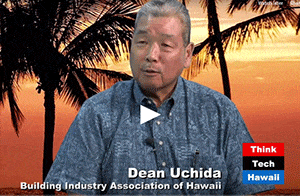 Solving Hawaii’s Housing Crisis
Solving Hawaii’s Housing Crisis
Building more housing is one of the Hawaiian Island’s greatest needs. SSFM’s Dean Uchida is this year’s president of the Building Industry Association Hawaii. In this ThinkTech interview, Dean talks about the restrictions that hinder the creation of more affordable housing and the necessary changes that will allow more homes to be built.
More / Less
BIA Hawaii’s leadership on housing issues includes many initiatives. Dean offers additional insights in this Solving Hawaii’s Housing Crisis article on the challenges facing the homebuilding industry.
One of BIA’s recent successes was Honolulu City Council’s approval of Bill 64 which establishes a 60 day time limit to process residential building permits.
 Solving Hawaii’s Housing Crisis
Solving Hawaii’s Housing Crisis
Building more housing is one of the Hawaiian Island’s greatest needs. SSFM’s Dean Uchida is this year’s president of the Building Industry Association Hawaii. In this ThinkTech interview, Dean talks about the restrictions that hinder the creation of more affordable housing and the necessary changes that will allow more homes to be built.
More / Less
BIA Hawaii’s leadership on housing issues includes many initiatives. Dean offers additional insights in this Solving Hawaii’s Housing Crisis article on the challenges facing the homebuilding industry.
One of BIA’s recent successes was Honolulu City Council’s approval of Bill 64 which establishes a 60 day time limit to process residential building permits.
December 2018
See the recovery website here:
See the recovery website here:
April 2019
Kauai County General Plan wins the American Planning Association’s top National Excellence Award for comprehensive planning.
The American Planning Association has selected the General Plan Update for the County of Kauai, Kauai Kākou, as the recipient of the 2019 Daniel Burnham Award. APA’s Daniel Burnham Award is the most prestigious honor the organization bestows for excellence in comprehensive planning.
More / Less
SSFM served as the Prime Consultant for the update of the Kauai General Plan. The General Plan is the guiding policy document for the County of Kauai, setting the island wide vision and goals, identifying Kauai’s unique qualities to be protected and preserved, and directing where and how growth should occur to ensure sustainability, resilience, and opportunity for all over the next twenty years. The project team deployed community engagement that sought widespread participation in developing a new General Plan framework consisting of a Vision statement, four overarching Goals, nineteen key Policies, 42 Objectives, and 607 Actions. The Plan was adopted by the Kauai County Council in 2018 and received the APA Hawaii Chapter’s 2018 Outstanding Planning Award.
Read more at: http://plankauai.com/
and https://www.planning.org/awards/2019/kauai/
“We are proud to be recognized as part of the team that developed this plan. The process was particularly groundbreaking in the way that it engaged the community throughout its development. The resulting plan views the entire community as a partner in implementation of the vision for Kaua‘i’s future,” explains Melissa White, Senior Planner and Associate at SSFM. “The County’s leadership was visionary in understanding and addressing long-standing community issues head on, and developing an action-oriented framework to guide Kaua‘i in growing responsibly.” The theme of the plan is Kaua’i Kākou, a Hawaiian concept meaning “we’re all in this together.” The planning process embraced collaboration and partnerships among government agencies, civic leaders, non-profit groups and the community. To address residents’ concerns about transparency in implementation, the plan establishes a regular monitoring cycle with several feedback points, and it calls for the creation of the Kākou Committee, which convenes every two years to review the plan.
 The General Plan Update addresses policy directions, ordinances, land use amendments, and prioritization of capital improvement projects in service of four goals:
The General Plan Update addresses policy directions, ordinances, land use amendments, and prioritization of capital improvement projects in service of four goals:
- A Sustainable Island: Growing responsibly to meet the needs of current and future generations without depleting resources.
- A Unique and Beautiful Place: Stewardship and protection of the natural, cultural, social, and built environment assets that are of value to the community.
- A Healthy and Resilient People: Increasing health, vitality, and resilience of communities through improving the natural, built, and social environment and responding to impacts from climate change.
- An Equitable Place, with Opportunity for All: Fostering diverse and equitable communities with vibrant economies, access to jobs and housing, and a high quality of lift.
The American Planning Association provides leadership in the development of vital communities by advocating excellence in planning, promoting education and citizen empowerment, and providing members with the tools and support necessary to meet the challenges of growth and change and to realize their mission of Creating Better Communities. The organization includes 42,000 members from 100+ countries. APA advances positive planning results through leadership in education, research, advocacy, and ethical practice.
See the recovery website here:
April 2019
Kauai County General Plan wins the American Planning Association’s top National Excellence Award for comprehensive planning.
The American Planning Association has selected the General Plan Update for the County of Kauai, Kauai Kākou, as the recipient of the 2019 Daniel Burnham Award. APA’s Daniel Burnham Award is the most prestigious honor the organization bestows for excellence in comprehensive planning.
More / Less
SSFM served as the Prime Consultant for the update of the Kauai General Plan. The General Plan is the guiding policy document for the County of Kauai, setting the island wide vision and goals, identifying Kauai’s unique qualities to be protected and preserved, and directing where and how growth should occur to ensure sustainability, resilience, and opportunity for all over the next twenty years. The project team deployed community engagement that sought widespread participation in developing a new General Plan framework consisting of a Vision statement, four overarching Goals, nineteen key Policies, 42 Objectives, and 607 Actions. The Plan was adopted by the Kauai County Council in 2018 and received the APA Hawaii Chapter’s 2018 Outstanding Planning Award.
Read more at: http://plankauai.com/
and https://www.planning.org/awards/2019/kauai/
“We are proud to be recognized as part of the team that developed this plan. The process was particularly groundbreaking in the way that it engaged the community throughout its development. The resulting plan views the entire community as a partner in implementation of the vision for Kaua‘i’s future,” explains Melissa White, Senior Planner and Associate at SSFM. “The County’s leadership was visionary in understanding and addressing long-standing community issues head on, and developing an action-oriented framework to guide Kaua‘i in growing responsibly.” The theme of the plan is Kaua’i Kākou, a Hawaiian concept meaning “we’re all in this together.” The planning process embraced collaboration and partnerships among government agencies, civic leaders, non-profit groups and the community. To address residents’ concerns about transparency in implementation, the plan establishes a regular monitoring cycle with several feedback points, and it calls for the creation of the Kākou Committee, which convenes every two years to review the plan.
 The General Plan Update addresses policy directions, ordinances, land use amendments, and prioritization of capital improvement projects in service of four goals:
The General Plan Update addresses policy directions, ordinances, land use amendments, and prioritization of capital improvement projects in service of four goals:
- A Sustainable Island: Growing responsibly to meet the needs of current and future generations without depleting resources.
- A Unique and Beautiful Place: Stewardship and protection of the natural, cultural, social, and built environment assets that are of value to the community.
- A Healthy and Resilient People: Increasing health, vitality, and resilience of communities through improving the natural, built, and social environment and responding to impacts from climate change.
- An Equitable Place, with Opportunity for All: Fostering diverse and equitable communities with vibrant economies, access to jobs and housing, and a high quality of lift.
The American Planning Association provides leadership in the development of vital communities by advocating excellence in planning, promoting education and citizen empowerment, and providing members with the tools and support necessary to meet the challenges of growth and change and to realize their mission of Creating Better Communities. The organization includes 42,000 members from 100+ countries. APA advances positive planning results through leadership in education, research, advocacy, and ethical practice.
See the recovery website here:
SSFM Wins 3 American Planning Association Hawaii Awards
Each year the Hawaii Chapter of the American Planning Association recognizes projects that exemplify the planning profession’s highest goals and ideals. The awards showcase great planning on the Islands and the significant contributions the planning community makes to the State of Hawaii. SSFM has been honored with 3 of only 8 awards presented in 2018.
More / Less
Professional planners and engineers from SSFM’s Strategic Services Group were honored for:
Outstanding Planning for their work with the County of Kauai Planning Department in developing the Kauai Kakou: Kauai County General Plan.
Transportation Planning for their work with the County of Hawaii Planning Department in developing the Downtown Hilo Multimodal Master Plan.
Community-Based Planning for the Waimanalo Community Values and Priorities for the Future project.
Read more about the American Planning Association Hawai`i Awards
October 2018
SSFM Wins 3 American Planning Association Hawaii Awards
Each year the Hawaii Chapter of the American Planning Association recognizes projects that exemplify the planning profession’s highest goals and ideals. The awards showcase great planning on the Islands and the significant contributions the planning community makes to the State of Hawaii. SSFM has been honored with 3 of only 8 awards presented in 2018.
More / Less
Professional planners and engineers from SSFM’s Strategic Services Group were honored for:
Outstanding Planning for their work with the County of Kauai Planning Department in developing the Kauai Kakou: Kauai County General Plan.
Transportation Planning for their work with the County of Hawaii Planning Department in developing the Downtown Hilo Multimodal Master Plan.
Community-Based Planning for the Waimanalo Community Values and Priorities for the Future project.
Read more about the American Planning Association Hawai`i Awards
October 2018
Favorable New Contracting Vehicle Now Available to SSFM’s Federal Clients
GSA Multiple Award Schedules (MAS) for Construction Management (SIN No. 871-7)
SSFM International is proud of all the work we do with various federal departments and agencies in Hawaii and throughout the entire Pacific rim. Now, thanks to a recently announced contract award from the US General Services Administration (GSA), SSFM can provide a full range of construction management services to federal agencies and departments on an accelerated contracting schedule and at favorable, pre-determined rates.
Favorable New Contracting Vehicle Now Available to SSFM’s Federal Clients
GSA Multiple Award Schedules (MAS) for Construction Management (SIN No. 871-7)
SSFM International is proud of all the work we do with various federal departments and agencies in Hawaii and throughout the entire Pacific rim. Now, thanks to a recently announced contract award from the US General Services Administration (GSA), SSFM can provide a full range of construction management services to federal agencies and departments on an accelerated contracting schedule and at favorable, pre-determined rates.
More / Less
The GSA has entered into a five-year Multiple Award Schedules (MAS) contract with SSFM for the delivery of Construction Management Services (SIN 871-7). Federal agencies and departments gain several benefits by engaging SSFM to deliver qualifying services included in this MAS contract. Since the contract is already in place, MAS serves as a vehicle to streamline the contracting process, reduce your costs, and speed the delivery of services:
• The cost for services provided is reduced because rates have been pre-negotiated and are based on volume discount pricing.
• Time and cost for contract administration are reduced.
• Agencies do not need to implement formal solicitation proposal processes, which saves time and reduces the risk of award protests.
• Compliance with Federal Acquisition Regulations and other applicable requirements is assured.
To learn more about SSFM’s MAS contract might benefit your federal agency or department, contact:
Stacey Miyamoto @ Tel: (808) 356-1275 or email: smiyamoto@ssfm.com
Louis Muzzarini @ Tel: (808) 356-1211 or email: lmuzzarini@ssfm.com
September 2018
More / Less
The GSA has entered into a five-year Multiple Award Schedules (MAS) contract with SSFM for the delivery of Construction Management Services (SIN 871-7). Federal agencies and departments gain several benefits by engaging SSFM to deliver qualifying services included in this MAS contract. Since the contract is already in place, MAS serves as a vehicle to streamline the contracting process, reduce your costs, and speed the delivery of services:
• The cost for services provided is reduced because rates have been pre-negotiated and are based on volume discount pricing.
• Time and cost for contract administration are reduced.
• Agencies do not need to implement formal solicitation proposal processes, which saves time and reduces the risk of award protests.
• Compliance with Federal Acquisition Regulations and other applicable requirements is assured.
To learn more about SSFM’s MAS contract might benefit your federal agency or department, contact:
Stacey Miyamoto @ Tel: (808) 356-1275 or email: smiyamoto@ssfm.com
Louis Muzzarini @ Tel: (808) 356-1211 or email: lmuzzarini@ssfm.com
September 2018
Design for the Community
Connecting to our communities is a fundamental commitment of everyone at SSFM. Our people chose to engage in many ways. Lulu Chun, a planner in our Strategic Services Group, recently had the opportunity to give back to her alma mater, the Department of Urban and Regional Planning at the University of Hawaii. Alumni of the Department now have a newly formed chapter of the UH Alumni Association, the DURP Ohana.
Design for the Community
Connecting to our communities is a fundamental commitment of everyone at SSFM. Our people chose to engage in many ways. Lulu Chun, a planner in our Strategic Services Group, recently had the opportunity to give back to her alma mater, the Department of Urban and Regional Planning at the University of Hawaii. Alumni of the Department now have a newly formed chapter of the UH Alumni Association, the DURP Ohana.


Along with her credentials as a planner, landscape architect and urban planner, Lulu has a keen interest in graphic design. Lulu volunteered to design the Chapter’s new identity. “The Hawaiian Islands are unlike any environment on the planet and the logo needed to explicitly say Hawaii,” says Lulu. She chose the taro leaf as the focal visual.
Along with her credentials as a planner, landscape architect and urban planner, Lulu has a keen interest in graphic design. Lulu volunteered to design the Chapter’s new identity. “The Hawaiian Islands are unlike any environment on the planet and the logo needed to explicitly say Hawaii,” says Lulu. She chose the taro leaf as the focal visual.
More / Less
The Taro’s Story
Taro is a staple of the Native Hawaiian diet and at the core of the Hawaiian culture. It is one of the best known, important, and reliable plants in all of Polynesia. Hawaiians take a deep pride in its profound history and consider it sacred. Various names for parts of the taro plant indicate its interwoven history with the Hawaiian people: the place where the stem meets the leaf is called the piko, or navel. The stem is the ha, the breath, and the cluster of shoots (or keiki, meaning children) that surround the mother plant are called an ohana, or family. The imagery of the taro’s broad and beautiful heart shaped leaf was a perfect visual metaphor for the Chapter’s identity.
For Lulu, the taro leaf was the embodiment of Hawaii’s sense of place. The orientation and color patterns of her taro leaf represents the unique system of environments Hawaii planners work in: ranging from mauka open space and agricultural lands, to developed urban areas, to expanses of coastline. Her logo embodies the complex and diverse situations planners must be prepared for in Hawaii. Lulu sculpted the shape of the leaf’s top edge to reflect the Island’s mountain ranges.
Lulu was welcomed as an intern at SSFM while pursuing her Master’s and joined the firm upon her graduation. As part of the Strategic Services Group, Lulu is engaged in Honolulu’s Complete Streets programs, utilizing her design skills to create easy-to-understand mobility plans.
April 2018
More / Less
The Taro’s Story
Taro is a staple of the Native Hawaiian diet and at the core of the Hawaiian culture. It is one of the best known, important, and reliable plants in all of Polynesia. Hawaiians take a deep pride in its profound history and consider it sacred. Various names for parts of the taro plant indicate its interwoven history with the Hawaiian people: the place where the stem meets the leaf is called the piko, or navel. The stem is the ha, the breath, and the cluster of shoots (or keiki, meaning children) that surround the mother plant are called an ohana, or family. The imagery of the taro’s broad and beautiful heart shaped leaf was a perfect visual metaphor for the Chapter’s identity.
For Lulu, the taro leaf was the embodiment of Hawaii’s sense of place. The orientation and color patterns of her taro leaf represents the unique system of environments Hawaii planners work in: ranging from mauka open space and agricultural lands, to developed urban areas, to expanses of coastline. Her logo embodies the complex and diverse situations planners must be prepared for in Hawaii. Lulu sculpted the shape of the leaf’s top edge to reflect the Island’s mountain ranges.
Lulu was welcomed as an intern at SSFM while pursuing her Master’s and joined the firm upon her graduation. As part of the Strategic Services Group, Lulu is engaged in Honolulu’s Complete Streets programs, utilizing her design skills to create easy-to-understand mobility plans.
April 2018
Wishing You a Prosperous and Joyful New Year
At years end we gather to celebrate the firm’s accomplishments. We pick a culinary theme for a cook-off between our professional groups. This year our theme was Game of Thrones. We’ve gathered the recipes which we offer for your enjoyment throughout the coming year. See our SSFM Cookbook.
January 2018
Wishing You a Prosperous and Joyful New Year
At years end we gather to celebrate the firm’s accomplishments. We pick a culinary theme for a cook-off between our professional groups. This year our theme was Game of Thrones. We’ve gathered the recipes which we offer for your enjoyment throughout the coming year. See our SSFM Cookbook.
January 2018
Civil Engineering Club Wins National Competition
SSFM is committed to improving STEM educational opportunities throughout the Islands. Our professionals are engaged in supporting a variety of science, technology, engineering and math programs at local schools and associations. SSFM’s Wendy McLain and Victor Valdez have just mentored the Civil Engineering Club at Roosevelt High School to a 1st place in the 2016-17 Civil Engineering Club Competition sponsored by the American Society of Civil Engineers (ASCE).
Read more about the STEM Civil Engineering Competition
October 2017
Civil Engineering Club Wins National Competition
SSFM is committed to improving STEM educational opportunities throughout the Islands. Our professionals are engaged in supporting a variety of science, technology, engineering and math programs at local schools and associations. SSFM’s Wendy McLain and Victor Valdez have just mentored the Civil Engineering Club at Roosevelt High School to a 1st place in the 2016-17 Civil Engineering Club Competition sponsored by the American Society of Civil Engineers (ASCE).
Read more about the STEM Civil Engineering Competition
October 2017
Introducing the SSFM Strategic Services Group
SSFM’s strategic services group engages a number of our core professional disciplines to analyze, plan, entitle, design and implement difficult environmental and real property assignments. The Group is dedicated to optimizing the value and returns of real estate assets through innovative and creative solutions that make complex real estate projects viable.
Strategic Services – What We Do
View our Strategic Services Brochure
June 2017
Introducing the SSFM Strategic Services Group
SSFM’s strategic services group engages a number of our core professional disciplines to analyze, plan, entitle, design and implement difficult environmental and real property assignments. The Group is dedicated to optimizing the value and returns of real estate assets through innovative and creative solutions that make complex real estate projects viable.
Strategic Services – What We Do
View our Strategic Services Brochure
June 2017
Complete Streets in Downtown/Chinatown
Over the next 2 to 4 years, Honolulu will be implementing a Complete Streets program in Downtown and Chinatown. SSFM has had the opportunity to steward the design process and review of the solutions that will be incorporated into the Chinatown improvement plans.
In just three months, we completed data collection and traffic analysis while gathering input and generating awareness and support for the program. We met a challenging accelerated schedule and now look forward to the transformation of these dynamic neighborhoods.
Complete Streets in Downtown/Chinatown White Paper
April 2017
Complete Streets in Downtown/Chinatown
Over the next 2 to 4 years, Honolulu will be implementing a Complete Streets program in Downtown and Chinatown. SSFM has had the opportunity to steward the design process and review of the solutions that will be incorporated into the Chinatown improvement plans.
In just three months, we completed data collection and traffic analysis while gathering input and generating awareness and support for the program. We met a challenging accelerated schedule and now look forward to the transformation of these dynamic neighborhoods.
Complete Streets in Downtown/Chinatown White Paper
April 2017
SSFM’s Commitment to Education
The December 2016 SSFM Focus posting announced our financial backing for the University of Hawaii, Mānoa College of Engineering and College of Social Sciences. Our commitment to education extends well beyond the University.
The SSFM family has long been engaged in wide ranging volunteer efforts in support of education. With our technical and engineering focus, we are particularly dedicated to programs that advance science, technology, engineering and math (STEM). We invite you to learn more about the many ways we are assisting scholastic programs throughout our communities.
SSFM’s Commitment to Education
February 2017
SSFM’s Commitment to Education
The December 2016 SSFM Focus posting announced our financial backing for the University of Hawaii, Mānoa College of Engineering and College of Social Sciences. Our commitment to education extends well beyond the University.
The SSFM family has long been engaged in wide ranging volunteer efforts in support of education. With our technical and engineering focus, we are particularly dedicated to programs that advance science, technology, engineering and math (STEM). We invite you to learn more about the many ways we are assisting scholastic programs throughout our communities.
SSFM’s Commitment to Education
February 2017
SSFM’s Funds University of Hawaii Scholarships and Fellowships
The University of Hawaii, Mānoa College of Engineering and College of Social Sciences is the recipient of a $261,263 contribution from SSFM International, Inc. The money will fund 4 full 4 year undergraduate scholarships in Civil and Environmental Engineering, and a 4 year Graduate Fellowship in Urban and Regional Planning.
“Supporting the next generation of engineers and planners is one of our key commitments to our profession and our community,” explains Michael Matsumoto, President/CEO of SSFM. “These scholarships will help make education possible for a number of students and partnering with UH allows SSFM to stay connected to the development of the next generation of design professional.”
Read the University of Hawaii Press Release
December 2016
SSFM’s Funds University of Hawaii Scholarships and Fellowship
The University of Hawaii, Mānoa College of Engineering and College of Social Sciences is the recipient of a $261,263 contribution from SSFM International, Inc. The money will fund 4 full 4 year undergraduate scholarships in Civil and Environmental Engineering, and a 4 year Graduate Fellowship in Urban and Regional Planning.
“Supporting the next generation of engineers and planners is one of our key commitments to our profession and our community,” explains Michael Matsumoto, President/CEO of SSFM. “These scholarships will help make education possible for a number of students and partnering with UH allows SSFM to stay connected to the development of the next generation of design professional.”
Read the University of Hawaii Press Release
December 2016





